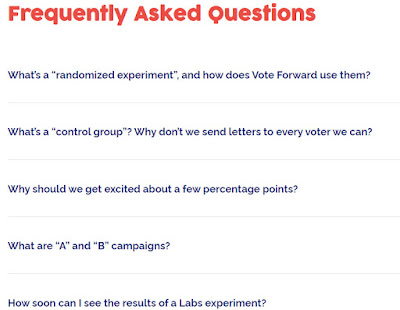Interpreting effect sizes requires more than Rules of Thumb for interpretation. Interpretation requires deeper knowledge about the investigated topic, an idea we must convey to our students. For example, in presidential elections in the United States, the winner is usually selected by a slim margin. As such, if you can get even small numbers of voters who don't usually vote to vote, it can have a large real-world effect on an election. This is what Vote Forward is trying to do, and I'll explain how you can use their work to explain effect sizes in your stats classes.
This is Vote Foreward:
Okay. So they are organizing letter-writing campaigns in advance of the 2020 General Election. NOTE: The organization is left-leaning, but many of its campaigns ask letter-writers to share non-partisan messages.
Vote Forward has tested whether or not writing letters to unlikely voters actually gets people to vote, and they shared the results of those efforts:
Their findings, which aren't particularly large, beg the question, "Why should we get excited about a few percentage points." Which they address in their FAQs.
So, this sounds like effect size. And why they require interpretation beyond rules of thumb. If you are trying to get people to do something they are doubtful about doing, and trying to get them to do is important, your "small" behavior changes are a big deal. Many volunteers can perform a task rather inexpensively, especially when the agent for behavioral change is writing a letter.
Another additional lesson you can use in this class: They do explain their research methodology, which you can discuss with your students:
3.6.22 update: There are multiple efficacy studies available here: https://votefwd.org/impact






Comments
Post a Comment